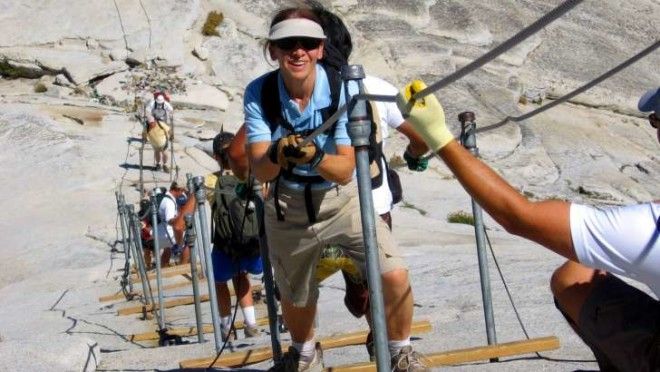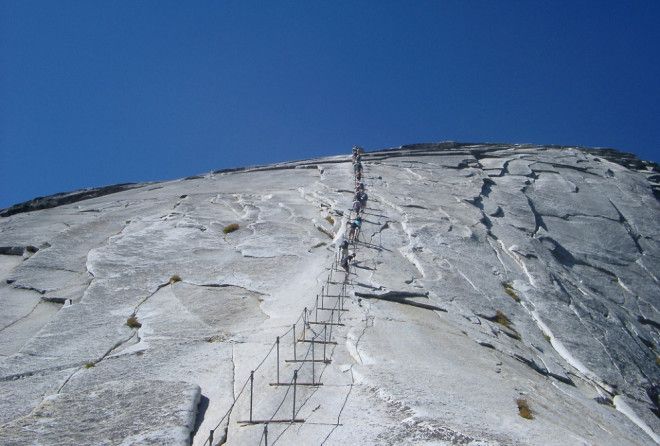1. THE HALF DOME CABLE ROUTE IN CALIFORNIA'S YOSEMITE NATIONAL PARK

While climbing Half Dome—the famed granite dome at Yosemite Valley in Yosemite National Park, California—hikers have to watch their step while scaling the formation’s slick eastern slope. The climb’s last 400 feet takes visitors up sheer rock, with cable ladders bolted into the granite for support. Multiple individuals have died while attempting this climb during or after a storm, so make sure to only tackle it if weather conditions are dry.
2. THE TRADITIONAL KNIFE LADDERS OF ZHONGTUAN, CHINA
Every three years, villagers in Zhongtuan, in southeast China's Fujian Province, hold a harvest festival on the 15th day of the 10th lunar month. One traditional festival custom requires barefoot men to climb a ladder made of 36 sharpened blades, after being blessed by senior villagers. The first man to finish the treacherous climb sits on a chair at the top and hands out prizes to the others who reach the top. Meanwhile, other cultures around China reportedly have their own versions of the painful practice, including the Bai people of Yunnan Province, who climb knife ladders as a religious rite.
3. THE 'SKY LADDERS' OF ATULEER, CHINA
Until recently students in the tiny rural village of Atuleer, in China’s country’s mountainous Sichuan province, had to climb down rickety "sky ladders"—a chain of 17 bamboo ladders affixed to a sheer, half-mile cliff—to attend a local school at the mountain’s base. In 2016, the state-run Beijing News ran a photo series of kids scaling the mountain, and reports surfaced that villagers had either died or been injured after falling from the ladders. Local government officials responded to the news by providing Atuleer’s residents with a sturdy steel ladder with handrails, which was completed in November 2016.
4. THE CHAIN LADDERS OF SOUTH AFRICA'S ROYAL NATAL NATIONAL PARK
Hike through Royal Natal National Park in the Northern Drakensberg, in South Africa, and you might be tempted to check out one of the region's most famous natural features: a dramatic rock wall called the Ampitheater, which stretches for roughly three miles and juts more than 1600 feet into the air. For an awe-inspiring view of the formation, visitors can tackle the so-called Chain Ladder Hike, a trail featuring rickety chain ladders that leads park-goers past the Tugela River and the world's second-tallest waterfall. This course requires hikers to shimmy up a sheer cliff face, so it isn't for the faint of heart. That said, they can also opt to travel along a safer route—a gully that leads to the mountain's top.
5. THE CABLE LADDERS OF GRAND CANARIA, IN SPAIN'S CANARY ISLANDS
When mountain adventurers visit the island of Gran Canaria, off the coast of Africa in Spain's Canary Islands, see the via ferrate—or cabled climbing routes—located across the mountainous region, they might be reminded of the Alps or the Dolomites, where via ferrate ("iron roads" in Italian) are more common. Here they can explore the volcanic region's dramatic peaks and caves on a series of protected climbing routes. Thin, slack cables called are bolted to the rock so hikers can climb hand-over-hand to reach the rugged island's highest peaks.
6. THE LADDER LEADING TO THE TOP OF THE KATSKHI PILLAR IN THE REPUBLIC OF GEORGIA
Long ago, residents of the western Georgian region of Imereti are said to have believed that the Katskhi pillar—a limestone monolith that looms more than 131 feet above the village of Katskhi—represented a fertility god. In later years, the natural pillar became a symbol of Christianity, and two churches were constructed at its top. The ancient churches were likely built between the 6th and 8th centuries CE by the Stylites, an early group of Christian ascetics who worshipped atop pillars. The sites were just recently restored by a local monk—and those brave enough to climb an steep iron ladder running from the Katskhi pillar's base to its top can visit them—and the monk who lives there—while also taking in a wider view of the surrounding countryside.
7. MOUNT HUASHAN IN CHINA
China’s Mount Huashan—an important Taoist landmark located around 75 miles from the historical capital of Xi’an—has a 7000-foot-high cliffside trail leading visitors up towards the mountain's peaks. A particularly perilous stretch between the south and east peaks features a series of wooden planks bolted to the mountain—and hikers are required to wear safety harnesses while carefully inching their way along the narrow path. At the journey's end, they can soothe their nerves by visiting a sky-high teahouse perched atop the southern peak, or relax under a pavilion to take in the view.

